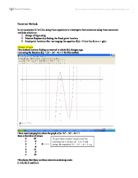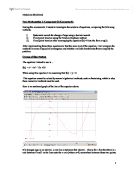Here is some variation of the decimals.
-0.79693 x10^ˉ7 is the closest I found that is 7d.p from 0.
Error bounds are (x = -0.79693 ± 0.000005) and my solution bounds are (-0.796925≤ x ≤ -0.796935)
This is the equation used for this graph
I am going to demonstrate that the root that lies between (1,5) can not be solved using the change of sign method.
I can now see from both the graph and the results in the tables that the graph sits on the x-axis and does not pass through to the negative y-axis so there would be no change in sign. So in certain cases the change of sign method would not be appropriate.
The Newton-Raphson Method
f(x)=0 is solved using the iteration
I am using the function f(x)=x³+6x²+4x for this method
I first plotted the graph of y= x³+6x²+4x to find any roots and this is what I got:
f(x)= x³+6x²+4x
f’(x)= 3x²+12x+4
Using excel I have found the roots
By using the Newton-Raphson equation
This is fixed point iteration
.
I have used autograph to both draw my graphs and display
a table of results to show where the root is
By using Newton Raphson method
So for my example Xo= -2
So (-2)³+6*(-2)²+4*(-2) = 8
3*(-2)²+12*(-2)+4 = -8
Then (-2) – 8/-8 = -1
And then carrying on the principle x would be replaced with -1
by looking for a change of sign I can identify my error bounds and the sign changes between -1 and -0.5 so -1= 1 and -0.5= -0.625
so by using excel I have imputed the x values into the equation y = x³+6x²+4x and here are the results:
x y
I can see there is a sign change
between -0.7 and -0.8
so I use 2 d.p
x y
I can see a sign change
Between -0.76 and -0.77
I can see a sign change
Between -0.763 and -0.764
I can see a sign change
Between -0.7639 and -0.7640
I can see a sign change
Between -0.76393 and -0.76394
I can see a sign change
Between -0.763932 and -0.763933
Root for solution bounds justified to 7 significant figures is f(-0.763933) < 0 and f(-0.763932) > 0
And my error bounds are (x= -0.763932 ± 0.0000005)
Here is an example of which Newton Raphson method fails to find a particular root despite using a starting value close to it.
Rearrangement method
Rearranging equations- any equation f(x) = 0 can be rearranged in the form x = g(x) in any number of ways, and can be used as a basis for the iteration xn+1 = g(xn).
So f(x) = x³ – 6x² – 2x + 1 = 0
Can be written as x = ½( x³ – 6x² + 1)
Or x= √(x³-2x+1)/6
Or x= ³√6x²+2x-1
There are many other ways for f(x)to be rearranged to a form of g(x). Some are unsuccessful where as some can lead to convergent or iterations.
The rearrangement x= ³√6x²+2x-1 gives the iteration x n+1 = ³√6x²n + 2xn -1 and this helps find the intersection of the curve y= ³√6x²+2x-1 and y = x.
Staircase diagram method
-
choose a value of x
- find the corresponding value of y
- make the value of y into the new value of x
- find the corresponding value of y
- and so on …..
This interaction converges
x n+1 = ³√6x²n + 2xn -1
I used this equation to find the value
of the root near (6,6) by using excel
and here are the results in the tables
below.
x y
x y
The error bound is x= 6.29257994 ± 0.000000005
The magnitude of g’(x) is important for the rearrangement method to succeed this is because the gradient of the graph must be less than 1 and if it is any larger the graph becomes divergent
G’(x)= √12x+2
From the graph above you can see where both the rearrangement is successful and where it fails this is because of the gradient of y=³√6x²+2x-1 at where the graph y=x interact near (-0.5,-0.5) is more than 1.
the reason for this fail is because the gradient of y=³√6x²+2x-1 is much larger than one meaning that section neither converges or diverges correctly so it was impossible to use both staircase diagram and cobweb diagram to determine the root.
x y
The
f(x)= 2x³–5x²–4x+1
f’(x)= 6x²–10x–4
x0-f(x)/f’(x)= 1-
I found that each method had its own advantages and disadvantages for me I found Newton raphson method easy to use on the computer because autograph has a special tool that works everything out for you.
One of the equations used above is selected and the
Other two methods are applied successfully to find the Same root. There is a sensible comparison of the relative merits of The three methods in terms of speed of convergence. There is a sensible comparison of the relative merits of the three methods in terms of ease of use with available hardware and software.







